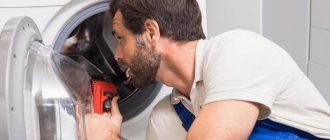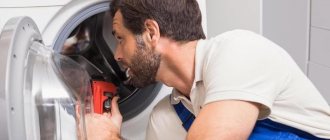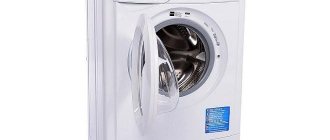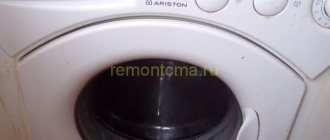Is your washing machine shaking and humming like a rocket about to take off? In this article we will talk about the main causes of noise and vibration during spinning. Let's look at how you can fix problems yourself and when you should still contact a specialist.
The connection manual is universal, suitable for all models with vertical and horizontal loading of the brands Ariston, Bosch, Candy, Gorenje, Indesit, Samsung, Siemens, Zanussi, Ariston, Bosch, Aeg, Beko, Electrolux, Haier and others.
Go!
Failure to comply with operating rules
The most common reason. The round shape of the drum helps to mix wet laundry into one pile. Manufacturers write in all instructions about the need to put small and medium-sized items into the machine along with large and bulky items to create balance. But it’s enough to leave one duvet cover unfastened for them all to become one big heap, which is difficult to turn around. To prevent such situations, you need to put the laundry folded for washing, making sure to fasten all the zippers and buttons.
Overload can also cause the washer to bounce and jump. In this case, stop the machine, drain the water and separate the laundry into parts. Always load laundry evenly, since the service life of the equipment depends on proper use.
Damper failure
Dampers or shock absorbers are designed to smooth out vibrations that occur during washing. Their condition is easy to check. To do this, you need to open the loading hatch door and try to pull the tank towards you, and then release it. If it falls into place, the shock absorbers are ok. If this is the reason, then the tank begins to oscillate unnaturally.
Most often damaged are the linings that extend from the tank and flow around its tubes. The linings are strongly pressed to these elements using special U-shaped rods. The rods themselves are attached to the washer tank.
To replace broken linings, you need to unscrew the bolts that secure the damper to the body of the main unit. Then remove the defective covers and put new ones in their place. To install, you will need to unclench the shoulders of the metal rods, place the lining and bring them together again.
The replacement process is complicated by the fact that manufacturers do not produce individual parts for shock absorbers of washing machines, so choosing a suitable lining is problematic. It is most advisable to replace the shock absorbers with new ones; moreover, their price is low.
Technical reasons
In addition to operational reasons, there are many other reasons why a machine knocks and moves (“dances”). Incorrect installation of equipment, failure of important parts and components. It can be difficult to fix such problems on your own. However, if they are diagnosed correctly, it is quite possible.
The floor is uneven or slippery
Uneven position of the legs is one of the common reasons that the machine rattles and bounces. To verify this, simply shake the machine. If it wobbles, determine which direction is more. And on this side, twist the leg, lifting it higher. This problem is common in homes with wood floors. Here you need to spend a lot of time to bring the machine into a perfectly level position.
Slippery floors are another possible cause. The washing machine simply rides on its rubberized legs on wet marble or tiles. Sometimes this happens on laminate flooring too. The solution may be to purchase special pads that will hold firmly even on the most slippery surfaces. Other options: an anti-slip silicone mat or moving it to another location.
Installation not level
If the machine is tilted to one side, the counterweight located inside the body, which holds it during operation, will be directed in that direction. This problem can be identified visually by examining the machine from a distance. If there is a building level, it will show exactly where the machine is tilted. To correct the situation, it is enough to place the equipment correctly.
Shipping bolts not removed
If the new machine hums, trembles and “walks”, the transport bolts may not have been removed. They are located on the back wall and are installed so that the drum remains in place during transportation. As a rule, there are four bolts. Unscrew with a regular screwdriver.
Don't throw them away: when moving, shipping bolts will help keep the mechanical insides of the machine intact.
Shock absorbers and dampers
Shock absorbers are cylinder-like parts with a rod, a piston and a “return” spring. Designed to dampen vibrations that appear at high speeds. Improved shock absorbers with an entire spring system are called “dampers”. Some modern car brands are equipped with them.
The service life of both is quite limited. They can fail if overloaded frequently. You can check the serviceability of the shock absorbers by removing the rear or front part of the car.
To begin with, try simply pressing on the tank. If it immediately snaps into place, then everything is fine with them. Otherwise, the tank will return with a slight delay.
All specified parts are paired. Therefore, if one shock absorber fails, both need to be replaced. Their cost is low, much cheaper than an additional call to a specialist. The same applies to dampers.
It's also worth checking the springs that support the tank. They are located on both sides and can stretch from prolonged use. They can also be replaced in pairs.
The engine runs rough
In addition to the stable and even noise of vibration or knocking, a completely different, sharp sound may occur, usually accompanied by a burning smell. This is a sign of engine failure. This happens due to its long service life, voltage surge or burnout of the armature winding.
If such sounds are produced by a recently purchased car, we are talking about a defective manufacturer. In this case, it is better to contact the service center while the warranty is valid (for washing machines, as a rule, for at least a year).
Objects stuck between drum and tank
Sometimes locks, brooches and other decorations fall out during washing. They fall into the holes of the drum and, periodically catching on it, make creaking sounds. To detect foreign objects, just look under the hatch cuff. If the object fell further, you will have to unscrew the heating element and other elements.
Bearings are worn out
The washing machine makes a characteristic noise and rumbles: the bearings may have failed. Rotate the drum by hand. Inhomogeneous rotation, sometimes quite difficult, indicates that it is time to replace this consumable.
If this is not done in a timely manner, excessive load will appear on the shaft and drum, which will lead to more expensive repairs in the future. Bearings are considered consumable items, requiring replacement every 3-5 years. Fortunately they are inexpensive. If you wish, you can replace them yourself.
The belt has dried out
If the drum spins too easily and produces an unpleasant scraping sound, there may be a problem with the direct drive. The drive belt serves to connect the drum and the engine. Infrequent use of the washing machine or prolonged work on worn out bearings leads to weakening of the tension. How to accurately determine that the problem is in the belt and what to do about it can be read here.
Damaged shaft
In addition to strong vibration and “jumping,” damage to the shaft may be indicated by rusty stains at the bottom of the washing machine. This is a serious breakdown. You won’t be able to fix it yourself without the proper experience.
Fastenings of internal elements are loose
Another reason why the washing machine “walks” and even “dances” on the surface may be insufficient fastening of the internal elements. If this is not corrected in a timely manner, several main components will fail at once. Therefore, you should check how well the crosspiece, counterweight and fasteners supporting the tank are tightened. If necessary, secure more firmly.
Why is all this dangerous?
The main problem is that during pulsation, the machine can easily tear away from the drain hose or from the water supply, and in this case, a flood in the home is guaranteed.
Frequent overload leads to belt wear and complete failure of the unit.
When working with a faulty belt, an unpleasant rubber smell and smoke may occur.
The machine will not be able to complete a full washing cycle if the drive belt is broken, since the water intake and drainage system is disrupted.
The drum may stop spinning or the appliance may start to leak if you continue to use the machine with faulty bearings.
Tips and tricks
In most cases, you can remove the vibration of the washing machine during the spin cycle yourself. To do this, it is enough to evaluate how level it is using a level. If you don’t have one, use a bottle half filled with water, on which draw a straight vertical line in the center. After this, place the container on the washer and see how much the water level deviates from the horizon.
To prevent the washing machine from jumping and humming here and now, you can use the following items:
- Place cardboard and thick paper under the legs on the swinging side.
- If the floor is too slippery, use a cotton rag - it will increase resistance and allow you to complete the wash cycle.
- In the future, it is better to buy an anti-vibration and anti-slip mat.
Visual inspection
First of all, it is necessary to do an external inspection of the machine and its location. The unit must be installed on a hard, level surface. It is unacceptable to install the machine on carpet or any other soft surfaces. If it is not possible to install the machine on a surface with the specified parameters, you need to make a special tray.
The machine must stand absolutely level, this can be easily achieved with the help of adjustable legs - set them level. You should also pay attention to the legs themselves. They usually have a rubber lining that is designed to soften vibrations. If the gasket is damaged, it should be replaced.
If everything is in order outwardly, then it’s worth looking “under the hood.” There are many reasons for excessive vibrations, let’s consider the possible options.
When to worry - additional signs
A malfunction should be suspected only when play in the washing machine drum is accompanied by the following additional symptoms, one or more:
- The washing machine makes a lot of noise, especially during the spin cycle.
- During the spin cycle, the drum knocks on the SMA body or on the glass of the hatch
- The machine jumps or vibrates strongly during the spin cycle
- The belt regularly falls off the pulley
- The drum rubs against the hatch cuff
- The machine seems to wash and spin normally, but it makes noise or creaks when the drum rotates
- Traces of an oily dark liquid are visible under the washing machine
- SM leaks from below, if you remove the back wall, rusty traces of leaks are visible on the tank
- The washing machine stains the laundry with black oil or rust stains
- The washing machine drum flew off and fell to the bottom of the tank
- The drum is jammed and rotates heavily with a metallic grinding noise.
- SMA chews on things
- The washing machine breaks plugs or smokes
- SM drum warped
Attention! A loose drum in combination with any of the listed symptoms indicates a serious malfunction. Even if the machine fully performs all cycles of the program, we do not recommend its operation. This will lead to more serious malfunctions, including the equipment being written off as scrap.
Loosening the counterweights
Counterweights are attached directly to the tank of the machine at the top and bottom. There are two types of counterweights used in washing machines:
- Plastic;
- Concrete.
Problems most often arise with concrete counterweights because they crumble over time. Also, due to constant vibration, the fastening bolts may become loose. The counterweights can be accessed by removing the top and front covers of the machine. If the problem is in the bolts, then you just need to tighten them. If the counterweight bursts, then it must be replaced with a similar one. Increased vibration is the main reason for rapid wear of washing machine parts.
Washing machine during spin cycle: drum rattles and unit vibrates
When spinning, the drum knocks loudly: what can you do yourself?
It is not recommended to try to repair serious faults at home, as this risks damaging fasteners, the tank cross and other parts. However, if you notice excessive noise or shaking during washing, follow these steps:
- Switch the machine to spin mode and after it has drained the water, open the drum and remove some of the laundry. Then turn it on again. If the knocking and vibration stop, then the problem was overload.
- Start the unit at idle speed, then turn on the spin program. If the centrifuge continues to rattle, then the problem is most likely a malfunction of the internal mechanisms.
- Bend the hatch cuff and inspect the space between the tank and the drum. If there is a foreign object there, try to remove it.
- Open the filter hole by first inserting the tray. Clean it of small debris.
If you cannot resolve the problem yourself, you need to call a specialist.











